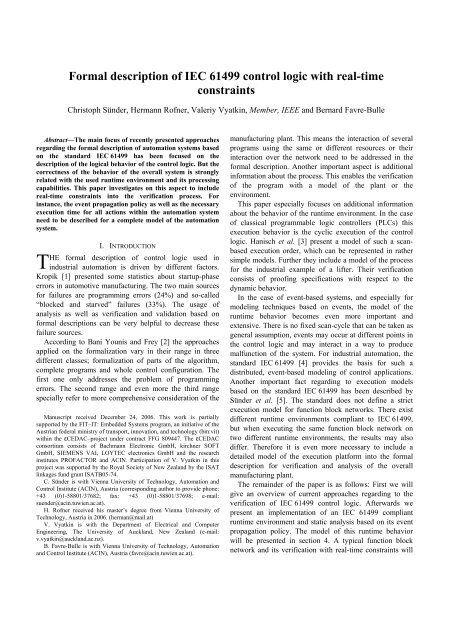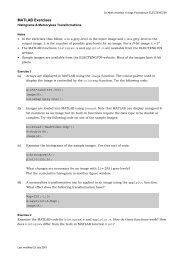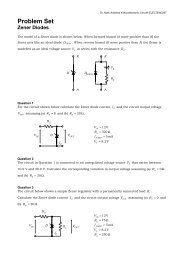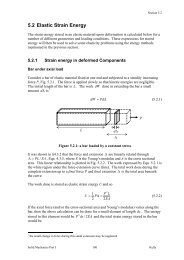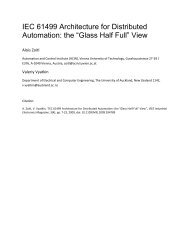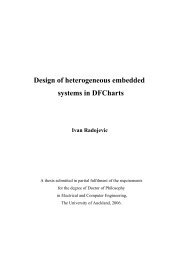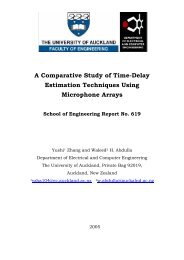Formal description of IEC 61499 control logic with - The University of ...
Formal description of IEC 61499 control logic with - The University of ...
Formal description of IEC 61499 control logic with - The University of ...
Create successful ePaper yourself
Turn your PDF publications into a flip-book with our unique Google optimized e-Paper software.
Abstract—<strong>The</strong> main focus <strong>of</strong> recently presented approaches<br />
regarding the formal <strong>description</strong> <strong>of</strong> automation systems based<br />
on the standard <strong>IEC</strong> <strong>61499</strong> has been focused on the<br />
<strong>description</strong> <strong>of</strong> the <strong>logic</strong>al behavior <strong>of</strong> the <strong>control</strong> <strong>logic</strong>. But the<br />
correctness <strong>of</strong> the behavior <strong>of</strong> the overall system is strongly<br />
related <strong>with</strong> the used runtime environment and its processing<br />
capabilities. This paper investigates on this aspect to include<br />
real-time constraints into the verification process. For<br />
instance, the event propagation policy as well as the necessary<br />
execution time for all actions <strong>with</strong>in the automation system<br />
need to be described for a complete model <strong>of</strong> the automation<br />
system.<br />
T<br />
<strong>Formal</strong> <strong>description</strong> <strong>of</strong> <strong>IEC</strong> <strong>61499</strong> <strong>control</strong> <strong>logic</strong> <strong>with</strong> real-time<br />
constraints<br />
Christoph Sünder, Hermann R<strong>of</strong>ner, Valeriy Vyatkin, Member, IEEE and Bernard Favre-Bulle<br />
I. INTRODUCTION<br />
HE formal <strong>description</strong> <strong>of</strong> <strong>control</strong> <strong>logic</strong> used in<br />
industrial automation is driven by different factors.<br />
Kropik [1] presented some statistics about startup-phase<br />
errors in automotive manufacturing. <strong>The</strong> two main sources<br />
for failures are programming errors (24%) and so-called<br />
“blocked and starved” failures (33%). <strong>The</strong> usage <strong>of</strong><br />
analysis as well as verification and validation based on<br />
formal <strong>description</strong>s can be very helpful to decrease these<br />
failure sources.<br />
According to Bani Younis and Frey [2] the approaches<br />
applied on the formalization vary in their range in three<br />
different classes; formalization <strong>of</strong> parts <strong>of</strong> the algorithm,<br />
complete programs and whole <strong>control</strong> configuration. <strong>The</strong><br />
first one only addresses the problem <strong>of</strong> programming<br />
errors. <strong>The</strong> second range and even more the third range<br />
specially refer to more comprehensive consideration <strong>of</strong> the<br />
Manuscript received December 24, 2006. This work is partially<br />
supported by the FIT–IT: Embedded Systems program, an initiative <strong>of</strong> the<br />
Austrian federal ministry <strong>of</strong> transport, innovation, and technology (bm:vit)<br />
<strong>with</strong>in the εCEDAC–project under contract FFG 809447. <strong>The</strong> εCEDAC<br />
consortium consists <strong>of</strong> Bachmann Electronic GmbH, kirchner SOFT<br />
GmbH, SIEMENS VAI, LOYTEC electronics GmbH and the research<br />
institutes PROFACTOR and ACIN. Participation <strong>of</strong> V. Vyatkin in this<br />
project was supported by the Royal Society <strong>of</strong> New Zealand by the ISAT<br />
linkages fund grant ISATB05-74.<br />
C. Sünder is <strong>with</strong> Vienna <strong>University</strong> <strong>of</strong> Technology, Automation and<br />
Control Institute (ACIN), Austria (corresponding author to provide phone:<br />
+43 (0)1-58801/37682; fax: +43 (0)1-58801/37698; e-mail:<br />
suender@acin.tuwien.ac.at).<br />
H. R<strong>of</strong>ner received his master’s degree from Vienna <strong>University</strong> <strong>of</strong><br />
Technology, Austria in 2006. (herman@mail.at)<br />
V. Vyatkin is <strong>with</strong> the Department <strong>of</strong> Electrical and Computer<br />
Engineering, <strong>The</strong> <strong>University</strong> <strong>of</strong> Auckland, New Zealand (e-mail:<br />
v.vyatkin@auckland.ac.nz).<br />
B. Favre-Bulle is <strong>with</strong> Vienna <strong>University</strong> <strong>of</strong> Technology, Automation<br />
and Control Institute (ACIN), Austria (favre@acin.tuwien.ac.at).<br />
manufacturing plant. This means the interaction <strong>of</strong> several<br />
programs using the same or different resources or their<br />
interaction over the network need to be addressed in the<br />
formal <strong>description</strong>. Another important aspect is additional<br />
information about the process. This enables the verification<br />
<strong>of</strong> the program <strong>with</strong> a model <strong>of</strong> the plant or the<br />
environment.<br />
This paper especially focuses on additional information<br />
about the behavior <strong>of</strong> the runtime environment. In the case<br />
<strong>of</strong> classical programmable <strong>logic</strong> <strong>control</strong>lers (PLCs) this<br />
execution behavior is the cyclic execution <strong>of</strong> the <strong>control</strong><br />
<strong>logic</strong>. Hanisch et al. [3] present a model <strong>of</strong> such a scanbased<br />
execution order, which can be represented in rather<br />
simple models. Further they include a model <strong>of</strong> the process<br />
for the industrial example <strong>of</strong> a lifter. <strong>The</strong>ir verification<br />
consists <strong>of</strong> pro<strong>of</strong>ing specifications <strong>with</strong> respect to the<br />
dynamic behavior.<br />
In the case <strong>of</strong> event-based systems, and especially for<br />
modeling techniques based on events, the model <strong>of</strong> the<br />
runtime behavior becomes even more important and<br />
extensive. <strong>The</strong>re is no fixed scan-cycle that can be taken as<br />
general assumption, events may occur at different points in<br />
the <strong>control</strong> <strong>logic</strong> and may interact in a way to produce<br />
malfunction <strong>of</strong> the system. For industrial automation, the<br />
standard <strong>IEC</strong> <strong>61499</strong> [4] provides the basis for such a<br />
distributed, event-based modeling <strong>of</strong> <strong>control</strong> applications.<br />
Another important fact regarding to execution models<br />
based on the standard <strong>IEC</strong> <strong>61499</strong> has been described by<br />
Sünder et al. [5]. <strong>The</strong> standard does not define a strict<br />
execution model for function block networks. <strong>The</strong>re exist<br />
different runtime environments compliant to <strong>IEC</strong> <strong>61499</strong>,<br />
but when executing the same function block network on<br />
two different runtime environments, the results may also<br />
differ. <strong>The</strong>refore it is even more necessary to include a<br />
detailed model <strong>of</strong> the execution platform into the formal<br />
<strong>description</strong> for verification and analysis <strong>of</strong> the overall<br />
manufacturing plant.<br />
<strong>The</strong> remainder <strong>of</strong> the paper is as follows: First we will<br />
give an overview <strong>of</strong> current approaches regarding to the<br />
verification <strong>of</strong> <strong>IEC</strong> <strong>61499</strong> <strong>control</strong> <strong>logic</strong>. Afterwards we<br />
present an implementation <strong>of</strong> an <strong>IEC</strong> <strong>61499</strong> compliant<br />
runtime environment and static analysis based on its event<br />
propagation policy. <strong>The</strong> model <strong>of</strong> this runtime behavior<br />
will be presented in section 4. A typical function block<br />
network and its verification <strong>with</strong> real-time constraints will
e described in section 5. We will summarize our approach<br />
in section 6 and give an outlook to future work.<br />
II. RELATED WORK<br />
<strong>The</strong>re exist several approaches for the formal <strong>description</strong><br />
<strong>of</strong> <strong>IEC</strong> <strong>61499</strong> <strong>control</strong> <strong>logic</strong> that have been described <strong>with</strong>in<br />
the recent years. <strong>The</strong>y can be separated according to one<br />
significant property; whether they include beside the model<br />
for function blocks (FBs) also a model <strong>of</strong> the runtime<br />
environment (event propagation <strong>with</strong>in the FB network) or<br />
not.<br />
A. <strong>Formal</strong> <strong>description</strong> <strong>of</strong> pure function blocks<br />
<strong>The</strong> first approach for a formal <strong>description</strong> <strong>of</strong> FBs<br />
according to <strong>IEC</strong> <strong>61499</strong> has been published by Vyatkin and<br />
Hanisch [6]. <strong>The</strong>y use net condition event systems (NCES)<br />
and therefore are able to combine analogies <strong>with</strong><br />
<strong>IEC</strong> <strong>61499</strong>. NCES modules can be interconnected by event<br />
and condition arcs to even bigger modules. Event<br />
propagation is modeled directly by event arcs. <strong>The</strong>refore,<br />
the runtime behavior is not mentioned. Further work based<br />
on this approach uses closed-loop verification <strong>of</strong> the<br />
<strong>control</strong>ler and the plant. Appropriate tool support and<br />
automatic generation <strong>of</strong> the formal model <strong>of</strong> the system are<br />
further topics presented <strong>with</strong>in this approach.<br />
<strong>The</strong> work <strong>of</strong> Vyaktin and Hanisch builds also the basis<br />
for current work from Lüder et al. [9].<br />
Wurmus and Wagner [12] present an approach for the<br />
formal <strong>description</strong> by use <strong>of</strong> Petri Nets. An event is<br />
represented by the flow <strong>of</strong> markings. Event FBs like<br />
E_DELAY are modeled <strong>with</strong>out regard to a concrete<br />
implementation <strong>with</strong>in a runtime environment.<br />
Schnakenbourg et al. [10] propose to model FBs using a<br />
synchronous language called SIGNAL. <strong>The</strong>y use clocks to<br />
assure the synchronization between the Execution Control<br />
Chart (ECC) and the input events. <strong>The</strong>re is no model<br />
included for the propagation <strong>of</strong> events according to a<br />
concrete runtime implementation. Physical time is also not<br />
included, but the authors claim that this can be overcome<br />
by giving a value to the gap between two instances <strong>of</strong> a<br />
clock.<br />
A rather new approach has been presented by Dubinin<br />
and Vyaktin [13] using the verification engine <strong>of</strong> Prolog<br />
language <strong>of</strong> <strong>logic</strong> programming, whose implementations<br />
contain a built-in deductive inference engine. <strong>The</strong>refore,<br />
the class <strong>of</strong> properties that can be checked is extended to<br />
more substantial queries providing in return not only “yes”<br />
or “no”, but also the parameters explaining the reasons. For<br />
instance, questions like “at which values <strong>of</strong> parameter X<br />
parameter Y belongs to an interval [a,b]. This approach is<br />
limited to basic FBs at the moment, but for further<br />
investigations also models <strong>of</strong> service interface FBs, a<br />
concept <strong>of</strong> time or distributed configurations are planned.<br />
B. <strong>Formal</strong> <strong>description</strong> <strong>of</strong> function blocks and their<br />
execution behavior<br />
Vyaktin [16] describes especially the modeling <strong>of</strong><br />
execution semantics <strong>of</strong> <strong>IEC</strong> <strong>61499</strong> function blocks by use<br />
<strong>of</strong> NCES. <strong>The</strong>se enhancements <strong>of</strong> [6] concentrate on the<br />
correct order <strong>of</strong> actions <strong>with</strong>in a FB as well as the<br />
propagation <strong>of</strong> events over the network by use <strong>of</strong> a<br />
scheduler, which provides sequential operation <strong>of</strong> events.<br />
<strong>The</strong>re is no runtime environment available for these<br />
models, further directions mentioned are a s<strong>of</strong>tware<br />
implementation as well as a hybrid hardware/s<strong>of</strong>tware<br />
implementation using Field Programmable Gate Arrays<br />
(FPGA).<br />
Stanica [7] provides a very simple model <strong>of</strong> the runtime<br />
behavior <strong>of</strong> an <strong>IEC</strong> <strong>61499</strong> execution platform. His<br />
approach is based on Timed Automata and takes into<br />
consideration the physical time <strong>of</strong> algorithm execution.<br />
Further the formal <strong>description</strong> restricts the execution <strong>of</strong><br />
algorithms to only one algorithm at the same time. But<br />
there are no models included to describe the propagation <strong>of</strong><br />
events and further runtime behavior.<br />
Khaligui et al. [11] propose a state machine model<br />
compliant to the standard <strong>IEC</strong> <strong>61499</strong>. To avoid<br />
unpredictable behavior in the case <strong>of</strong> simultaneous<br />
occurrences <strong>of</strong> events they propose to design <strong>of</strong>fline<br />
scheduling <strong>of</strong> FB execution. <strong>The</strong>y verify the scheduling<br />
correctness using the state machine model. By use <strong>of</strong> this<br />
scheduler a hard-coded execution model <strong>of</strong> a runtime<br />
environment can be implemented.<br />
Cengic et al. [8] describe their formal model <strong>of</strong> the<br />
runtime environment FUBER, which they have developed<br />
based on interacting finite automata in Supremica. In this<br />
case the formal <strong>description</strong> includes many aspects <strong>of</strong> the<br />
runtime behavior. For instance, the event execution model<br />
specifies that each FB instance must wait for another<br />
instance to finish its event handling before it can begin its<br />
own event handling. Incoming events <strong>of</strong> a FB instance are<br />
stored in a queue; all FB instances waiting for execution are<br />
also handled in another queue. By use <strong>of</strong> such a detailed<br />
formal <strong>description</strong> <strong>of</strong> the runtime behavior, they are able to<br />
pro<strong>of</strong> in many details the behavior <strong>of</strong> the FUBER<br />
implementation. Physical time is not mentioned in their<br />
approach. As the implementation <strong>of</strong> FUBER is based on<br />
Java, the virtual machine as well as the underlying<br />
operating system need to be included to the models for the<br />
consideration <strong>of</strong> physical time.<br />
III. THE C++FBRT<br />
As already described in the previous sections, the formal<br />
<strong>description</strong> <strong>of</strong> <strong>control</strong> <strong>logic</strong> according to <strong>IEC</strong> <strong>61499</strong> needs<br />
to be based on the principles for event propagation <strong>of</strong> a<br />
concrete runtime environment. This paper focuses on the<br />
<strong>IEC</strong> <strong>61499</strong> runtime environment (C++FBRT) developed
during the recent years at the Vienna <strong>University</strong> <strong>of</strong><br />
Technology. A short <strong>description</strong> <strong>of</strong> its behavior is given by<br />
Rumpl et al. [14]. <strong>The</strong> C++FBRT targets at resourcelimited<br />
embedded systems and does not need an underlying<br />
operating system. It has been implemented in C++.<br />
A. <strong>The</strong> behavior <strong>of</strong> the C++FBRT<br />
<strong>The</strong>re are very different ways <strong>of</strong> executing function<br />
block networks according to <strong>IEC</strong> <strong>61499</strong> available. Sünder<br />
et al. [5] gives a short overview on the variety available at<br />
the moment. <strong>The</strong> basic idea <strong>of</strong> propagating events <strong>with</strong>in<br />
the C++FBRT is the usage <strong>of</strong> a so-called event dispatcher.<br />
If any event occurs <strong>with</strong>in the runtime environment, the<br />
event source registers this event to the event dispatcher.<br />
<strong>The</strong> event dispatcher is a first-in first-out (FIFO) queue. If<br />
the runtime environment is able to execute a FB instance,<br />
the eldest event registered <strong>with</strong>in the event dispatcher is<br />
removed and executed. This means, the runtime<br />
environment executes all function blocks that are connected<br />
to this output event. <strong>The</strong> order <strong>of</strong> execution <strong>of</strong> connected<br />
FB instances is the same as in the eXtendable Markup<br />
Language (XML)-<strong>description</strong> <strong>of</strong> the function block<br />
network. <strong>The</strong> standard <strong>IEC</strong> <strong>61499</strong> defines, that there are<br />
only one-to-one event connections possible. If a one-tomany<br />
connection is necessary, the E_SPLIT FB has to be<br />
used. As a shorthand notation the order <strong>of</strong> the connections<br />
<strong>with</strong>in the XML-<strong>description</strong> is considered. <strong>The</strong> E_SPLIT<br />
FB is not mentioned explicitly as FB instance, but the<br />
behavior <strong>of</strong> the E_SPLIT FB is modeled <strong>with</strong>in the FB<br />
output as a list <strong>of</strong> connected event inputs <strong>of</strong> FB instances.<br />
<strong>The</strong> standard also defines an E_MERGE FB to model<br />
many-to-one event connections for an event input. As there<br />
is only one event occurring at the same time, this FB<br />
instance can be neglected in this implementation.<br />
Figure 1 depicts the situation <strong>of</strong> event propagation <strong>with</strong>in<br />
the C++FBRT in more detail. Let’s assume that there is no<br />
FB instance executing <strong>with</strong>in the C++FBRT. <strong>The</strong> runtime<br />
environment is idle. This means it is trying to remove an<br />
event from the event dispatcher. As there is no event <strong>with</strong>in<br />
the event dispatcher, it tries again. If the output event EO1<br />
occurs, it will be registered to the event dispatcher. When<br />
execution <strong>of</strong> FB1 has finished, the runtime environment<br />
will remove EO1 from the event dispatcher and then goes<br />
to the corresponding output event. Within there, a list <strong>of</strong><br />
connected event inputs is registered. In the case <strong>of</strong> EO1,<br />
only one event input (EI1) is registered and FB2 is<br />
executed by the occurrence <strong>of</strong> EI1. In this example, FB2<br />
sends the output event EO2. <strong>The</strong>refore, EO2 is put into the<br />
event dispatcher (Please note, that Figure 1 shows two<br />
events <strong>with</strong>in the event dispatcher. But at this time, only<br />
EO2 is registered the event dispatcher). After execution <strong>of</strong><br />
FB2 has finished, the runtime environment removes EO2<br />
from the event dispatcher. <strong>The</strong> list <strong>of</strong> connected event<br />
inputs <strong>of</strong> EO2 includes two event inputs. <strong>The</strong>refore, first<br />
FB3 is executed by the occurrence <strong>of</strong> EI2, afterwards FB4<br />
is executed by the occurrence <strong>of</strong> EI3. Now no more events<br />
are <strong>with</strong>in the event dispatcher and the runtime<br />
environment is idle again.<br />
Figure 1: Event propagation <strong>with</strong>in the C++FBRT<br />
During registration <strong>of</strong> an event to the event dispatcher an<br />
important mechanism has to be mentioned. Due to the fact,<br />
that data inputs are implemented as direct pointers to data<br />
outputs <strong>of</strong> FBs, data inconsistencies occur if an event is put<br />
twice into the event dispatcher. This means, the first event<br />
occurrence has not been executed until this event occurs<br />
again (see [14] for more details). <strong>The</strong>refore, if an event is<br />
registered to the event dispatcher, it will be checked<br />
whether this event is already registered to the event<br />
dispatcher. If yes, it will not be registered.<br />
Besides this procedure <strong>of</strong> event propagation, the<br />
mechanism <strong>of</strong> event occurrence due to external interrupts is<br />
an essential part <strong>of</strong> the runtime environment. We have to<br />
distinguish between two sources <strong>of</strong> interrupts; the timing<br />
interrupt and all other kinds <strong>of</strong> interrupts. <strong>The</strong> standard<br />
<strong>IEC</strong> <strong>61499</strong> defines a list <strong>of</strong> event FBs that are responsible<br />
for timing behavior. For instance, if the E_DELAY FB<br />
receives an input event, a certain time afterwards the output<br />
event occurs. Another example is the E_CYCLE FB,<br />
capable <strong>of</strong> providing cyclic occurrences <strong>of</strong> output events.<br />
To handle these event FBs, the C++FBRT uses a timer<br />
interrupt occurring every millisecond. If for instance an<br />
E_DELAY FB instance receives an event, it registers itself<br />
to the timer. If the time duration has elapsed, the timer<br />
interrupt invokes the FB instance which puts its output<br />
event into the event dispatcher.<br />
Any other external event sources can invoke the<br />
appropriate FB instance from the context <strong>of</strong> their interrupt<br />
and put the output event into the event dispatcher.<br />
To completely describe the behavior <strong>of</strong> the C++FBRT,<br />
also the internals <strong>of</strong> FB instances have to be described. As<br />
it will not be used <strong>with</strong>in the following <strong>description</strong>s, we<br />
leave out a detailed <strong>description</strong> <strong>of</strong> FB instance execution.<br />
Composite FBs are executed the same way as FB networks,<br />
basic FBs and service interface FBs according to the<br />
requester primitive are executed by invocation <strong>of</strong> one event<br />
input. Within the C++FBRT it is not possible that two
events can occur simultaneously. Service interface FBs<br />
concerning to the responder primitive have been already<br />
described above, as they are invoked by an external<br />
interrupt source.<br />
B. Static timing analysis <strong>of</strong> event propagation<br />
If we consider the timing behavior <strong>of</strong> the C++FBRT by<br />
itself, we can find a simple <strong>description</strong> <strong>of</strong> this behavior. As<br />
soon as an event is registered to the event dispatcher, the<br />
runtime environment behaves in a deterministic manner. Of<br />
course, the execution <strong>of</strong> such a function block network can<br />
be interrupted by event occurrences due to external<br />
interrupts. Within the following, we neglect such external<br />
event sources. <strong>The</strong> starting point <strong>of</strong> this static timing<br />
analysis is that an output event has been registered to the<br />
event dispatcher. <strong>The</strong> following execution the FB network<br />
will not be disturbed by external interrupts.<br />
Based on these preconditions, the timing behavior <strong>of</strong> the<br />
FB network can be described <strong>with</strong> a rather small set <strong>of</strong><br />
parameters and simple formulas. <strong>The</strong> main parameter for a<br />
function block itself is its execution time tFB. This<br />
parameter gives the time from the invocation <strong>of</strong> an FB<br />
(generally speaking the concrete input event has to be<br />
mentioned) until he has finished execution. This includes<br />
also registration <strong>of</strong> output events to the event dispatcher.<br />
This time is constant in case <strong>of</strong> the C++FBRT, if we<br />
assume an empty event dispatcher. <strong>The</strong>refore it can be<br />
assigned to tFB. If there are already events registered to the<br />
event dispatcher, the C++FBRT checks if this event is<br />
already included in the dispatcher (as described in section<br />
III.A). <strong>The</strong> time necessary for this check is application<br />
dependent and is constant for each event <strong>with</strong>in the event<br />
dispatcher. <strong>The</strong>refore we can model this time tEvFB by the<br />
product <strong>of</strong> the current number <strong>of</strong> events <strong>with</strong>in the event<br />
dispatcher NEv and the constant time for checking one event<br />
tEv, as in (1).<br />
t = t ⋅ N<br />
(1)<br />
EvFB<br />
Ev<br />
Ev<br />
If the execution <strong>of</strong> a FB has finished, the C++FBRT<br />
takes the next event from the event dispatcher. This takes<br />
place in constant time, described by the parameter tWs. This<br />
exactly describes all actions from fetching an event from<br />
the event dispatcher, looking at the list <strong>of</strong> connected input<br />
events <strong>with</strong>in the output event, and taking the first input<br />
event for invocation. <strong>The</strong>refore this parameter characterizes<br />
the execution <strong>of</strong> a serial path <strong>with</strong>in the FB network. Each<br />
output event is connected to only one input event, all FBs<br />
are executed sequentially. <strong>The</strong> upper part <strong>of</strong> Figure 2<br />
depicts exactly this situation. (2) gives the appropriate<br />
formula to calculate the execution time <strong>of</strong> this serial path<br />
<strong>with</strong>in the C++FBRT, tpath_s.<br />
t<br />
= t + t + t + t + t + ...<br />
path _ s FBs 1 EvFBs 1 Ws FBs 2 EvFBs 2<br />
(2)<br />
+ t<br />
Ws<br />
+ t<br />
FBsn<br />
+ t<br />
EvFBsn<br />
If there are several input events connected to an output<br />
event, the list <strong>with</strong>in the output event includes two or more<br />
entries. <strong>The</strong> parameter tWs characterizes the time for<br />
fetching the first element <strong>of</strong> this queue, all further events<br />
can be fetched from the list. This again happens in constant<br />
time, but since the event dispatcher is not involved it takes<br />
place faster. <strong>The</strong> appropriate parameter is tWbr. <strong>The</strong>refore<br />
the execution time for a so-called branching path (all<br />
execution from the second to the last connection <strong>of</strong> one<br />
output event to any other events) can be calculated<br />
according to (3). <strong>The</strong> lower part <strong>of</strong> Figure 2 depicts the<br />
situation <strong>of</strong> a branching path. (3) includes all FBs and the<br />
fetching <strong>of</strong> the input event from the list beneath the serial<br />
path.<br />
t<br />
path _ br Wbr FBb 1 EvFBb 1 Wbr FBb 2 EvFBb 2 (3)<br />
+ t<br />
= t + t + t + t + t + t + ...<br />
Wbr<br />
+ t<br />
FBbm<br />
+ t<br />
EvFBbm<br />
Figure 2: Description <strong>of</strong> (1) and (2)<br />
To summarize the static analysis <strong>of</strong> the C++FBRT, all<br />
mentioned parameters and their <strong>description</strong> are collected in<br />
Table 1.<br />
Parameter Description<br />
tFB Execution time <strong>of</strong> a FB<br />
tEvFB Time for evaluation <strong>of</strong> events <strong>with</strong>in the<br />
event dispatcher<br />
tWs Waiting time for fetching the next event<br />
from the event dispatcher<br />
tWbr Waiting time for fetching the next event<br />
<strong>with</strong>in the list <strong>of</strong> connected event inputs<br />
NEv Current number <strong>of</strong> events <strong>with</strong>in the event<br />
dispatcher<br />
tEv Time for checking one event <strong>with</strong>in the<br />
event dispatcher<br />
Execution time <strong>of</strong> a serial path<br />
tpath_s
Execution time <strong>of</strong> a branching path<br />
tpath_br<br />
Table 1: Parameters for static analysis <strong>of</strong> event propagation <strong>with</strong>in the<br />
C++FBRT<br />
IV. FORMAL DESCRIPTION OF THE C++ FBRT<br />
<strong>The</strong> C++FBRT is modeled by use <strong>of</strong> Net<br />
Condition/Event Systems (NCES). A brief overview <strong>of</strong><br />
NCES is available in Vyaktin [16].<br />
Description <strong>of</strong> the modeling <strong>of</strong> the Queue <strong>with</strong>in the<br />
event dispatcher for 3 events and 5 places (including a<br />
figure)<br />
• What happens during registration to the event<br />
dispatcher<br />
• What happens during fetching from the event<br />
dispatcher<br />
Description <strong>of</strong> the model for a list <strong>of</strong> connected FBs<br />
<strong>with</strong>in an output event. (figure ?)<br />
Description <strong>of</strong> the operation <strong>of</strong> the C++FBRT, the<br />
“<strong>control</strong>” model always fetching events (figure ?)<br />
Description <strong>of</strong> the Timing interfaces <strong>with</strong>in the<br />
C++FBRT (including a figure)<br />
• Mutual exclusion for access to the event<br />
dispatcher<br />
A. Implementation <strong>of</strong> physical time in the NCES models<br />
Interruption <strong>of</strong> the operation <strong>of</strong> a NCES-model<br />
• General behavior <strong>of</strong> NCES – doing things in<br />
steps (Is [16] sufficient as reference for that?)<br />
• Use a special condition for the sake <strong>of</strong> blocking<br />
execution (connected to all transitions <strong>with</strong>in<br />
the relevant part <strong>of</strong> the model)<br />
• Blocking <strong>of</strong> timed conditions (including a<br />
figure)<br />
V. COMPARISON OF RESULTS<br />
According to the methologies presented in this paper, we<br />
have compared our approaches by use <strong>of</strong> a simple function<br />
block network depicted in Figure 3. <strong>The</strong> test environment<br />
was a Infineon C167CS micro<strong>control</strong>ler (µC), mounted on<br />
a development board phyCORE-167-HS/E. This simple 16<br />
bit µC is sufficient to execute the C++FBRT. More details<br />
about the µC as well as the measurement procedure can be<br />
found in R<strong>of</strong>ner [15].<br />
This example can be analyzed by three different test<br />
cases. <strong>The</strong> first one (TC 1) is direct measurement <strong>of</strong> the<br />
execution behavior <strong>of</strong> the overall runtime environment.<br />
<strong>The</strong>refore the method <strong>of</strong> setting and reseting Boolean<br />
outputs is used, the measurements can be applied by use <strong>of</strong><br />
a digital oscilloscope. You can find our results concerning<br />
to this test case in Table 3 <strong>with</strong>in the second column.<br />
<strong>The</strong> second test case (TC 2) consists <strong>of</strong> the measurement<br />
<strong>of</strong> the parameters defined in Table 1 and applying the<br />
method <strong>of</strong> static timing analysis. <strong>The</strong> results <strong>of</strong> this method<br />
are presented in Table 3, third column. To give an example<br />
for the calculation <strong>of</strong> these results, we provide the<br />
algorithm for the measurement from the fetching <strong>of</strong> event<br />
Clock.EO to the finishing <strong>of</strong> the execution <strong>of</strong> FB3. <strong>The</strong><br />
values <strong>of</strong> the parameters for the test environment are<br />
presented in Table 2. <strong>The</strong> formula for the calculation <strong>of</strong> the<br />
mentioned execution path is mentioned in (4).<br />
Parameter Value for test environment<br />
tFB<br />
15,45 µs (for instances <strong>of</strong> simpleFB)<br />
tWs<br />
31,34 µs<br />
tWbr<br />
25,91 µs<br />
1,35 µs<br />
tEv<br />
Table 2: Time values for the parameters from the test environment<br />
???? (4)<br />
Description <strong>of</strong> formula (4).<br />
Figure 3: Example Function Block Network<br />
<strong>The</strong> third test case (TC 3) is the formal verification <strong>of</strong><br />
this example and extraction <strong>of</strong> the timing information from<br />
the possible paths <strong>with</strong>in the state space <strong>of</strong> this system. <strong>The</strong><br />
system that is modeled consists <strong>of</strong> the µC (timing interrupt<br />
and physical execution time), the C++FBRT and the<br />
application depicted in Figure 3. <strong>The</strong> verification is<br />
provided by the tool iMATCh (Integrated Model<br />
Assembler Translator and Checker) from Valeriy Vyaktin.<br />
A brief <strong>description</strong> <strong>of</strong> the tool is available in [3].<br />
Description <strong>of</strong> the state space <strong>of</strong> the system and the<br />
extraction <strong>of</strong> the timing information from the model<br />
checker.<br />
End point TC 1 TC 2 TC 3<br />
FB3<br />
finished<br />
137,79 µs 137,64 µs ?<br />
FB4<br />
finished<br />
181,79 µs 181,7 µs ?
FB5<br />
finished<br />
FB6<br />
finished<br />
231,29 µs 231,19 µs ?<br />
276,29µs 275,6 µs ?<br />
Table 3: Comparison <strong>of</strong> the results <strong>of</strong> the three test cases. <strong>The</strong> starting<br />
point <strong>of</strong> all values is fetching <strong>of</strong> event Clock.EO from the event dispatcher<br />
VI. CONCLUSION AND OUTLOOK<br />
To be written in January!<br />
ACKNOWLEDGMENT<br />
<strong>The</strong> authors want to thank Alois Zoitl for his previous<br />
work on the implementation <strong>of</strong> the C++FBRT as well as<br />
fruitful discussions during the construction <strong>of</strong> our formal<br />
<strong>description</strong> <strong>of</strong> this runtime environment.<br />
REFERENCES<br />
[1] M. Kropik, “Distributed Automation in Automotive<br />
Manufacturing—Current Status and Strategies”, 18 th [2]<br />
Internatinal<br />
cooperation symposium industry-research, 13th September 2005,<br />
Vienna, Austria<br />
M. Bani Younis, G. Frey, G, “<strong>Formal</strong>ization <strong>of</strong> Existing PLC<br />
Programs: A Survey”, Proceedings <strong>of</strong> the IEEE/IMACS<br />
Multiconference on Computational Engineering in Systems<br />
[3]<br />
Applications (CESA 2003), 2003<br />
H.-M. Hanisch, A. Lobov, J.L. Martinez Lastra, R. Tuokko, V.<br />
Vyatkin, “<strong>Formal</strong> validation <strong>of</strong> intelligent-automated production<br />
systems: towards industrial applications”, Int. Journal Manufacturing<br />
Technology and Management, Vol. 8, No. 1/2/3, 2006<br />
[4] International Electrotechnical Commission, “<strong>IEC</strong> <strong>61499</strong>-1: Function<br />
Blocks - Part 1 Architecture”, International Standard, First Edition,<br />
Geneva, 2005-01<br />
[5] C. Sünder, A. Zoitl, J.H. Christensen, V. Vyatkin, R.W. Brennan, A.<br />
Valentini, L. Ferrarini, T. Strasser, J.L. Martinez-Lastra, F. Auinger,<br />
“Interoperability and Useablity <strong>of</strong> <strong>IEC</strong> <strong>61499</strong>”, Proceedings <strong>of</strong> the<br />
IEEE Int. Conference on Industrial Informatics (INDIN’06), pp. 31-<br />
37, 2006<br />
[6] V. Vyatkin, H.-M. Hanisch, “ A modeling approach for verification<br />
<strong>of</strong> <strong>IEC</strong><strong>61499</strong> function blocks using net condition/event systems”,<br />
Proceedings <strong>of</strong> IEEE Int. Conference on Emerging Technologies and<br />
Factory Automation (ETFA’99), pp. 261-270, 1999<br />
[7] M. Stanica, “Behavioral Modeling <strong>of</strong> <strong>IEC</strong> <strong>61499</strong> Control<br />
Applications”, PhD report, Universite de Rennes, 2005<br />
[8] G. Cengic, O. Ljungkrantz, K. Akesson, “<strong>Formal</strong> Modeling <strong>of</strong><br />
Function Block Applications Running in <strong>IEC</strong> <strong>61499</strong> Execution<br />
Runtime”, Proceedings <strong>of</strong> IEEE Int. Conference on Emerging<br />
Technologies and Factory Automation (ETFA’06), pp. 1269-1276,<br />
2006<br />
[9] A. Lüder, C. Schwab, M. Tangermann, J. Peschke, „<strong>Formal</strong> models<br />
for the verification <strong>of</strong> <strong>IEC</strong> <strong>61499</strong> function block based <strong>control</strong><br />
applications”, Proceedings <strong>of</strong> IEEE Int. Conference on Emerging<br />
Technologies in Factory Automation (ETFA’05), pp. 105-112, 2005<br />
[10] C. Schnakenbourg, J.-M. Faure, J.-J.Lesage, “Towards <strong>IEC</strong> <strong>61499</strong><br />
function blocks diagrams verification”, Proceedings <strong>of</strong> the IEEE<br />
International Conference on Systems, Man and Cybernetics, vol. 3,<br />
2002<br />
[11] M. Khaligui, X. Rebeuf, F. Simonot-Lion, “A behavior model for<br />
<strong>IEC</strong> <strong>61499</strong> function blocks”, Proceedings <strong>of</strong> the 3rd Workshop on<br />
Modelling <strong>of</strong> Objects, Components, and Agents, pp. 71-88, 2004<br />
[12] H. Wurmus, B. Wagner, “<strong>IEC</strong> <strong>61499</strong> konforme Beschreibung<br />
verteilter Steuerungen mit Petri-Netzen“, Fachtagung Verteilte<br />
Automatisierung, 2000<br />
[13] V. Dubinin, V. Vyatkin, H.-M. Hanisch, „Modelling and Verification<br />
<strong>of</strong> <strong>IEC</strong> <strong>61499</strong> Applications using Prolog“, Proceedings <strong>of</strong> IEEE Int.<br />
Conference on Emerging Technologies and Factory Automation<br />
(ETFA’06). pp. 774-781, 2006<br />
[14] W. Rumpl, F. Auinger, C. Dutzler, A. Zoitl, „Platforms for scalable<br />
flexible automation considering the concepts <strong>of</strong> <strong>IEC</strong> <strong>61499</strong>”,<br />
BASYS’02, Cancun, Mexico, 2002<br />
[15] H. R<strong>of</strong>ner, “Abarbeitung von <strong>IEC</strong> <strong>61499</strong> Funktionsblocknetzwerken—Charakterisierung<br />
einer Laufzeitumgebung”, Master<br />
thesis, Vienna <strong>University</strong> <strong>of</strong> Technology, 2006<br />
[16] V. Vyatkin, „Execution Semantic <strong>of</strong> Function Blocks based on the<br />
Model <strong>of</strong> Net Condition/Event Systems“, Proceedings <strong>of</strong> the IEEE<br />
Int. Conference on Industrial Informatics (INDIN’06), pp.874-879,<br />
2006


